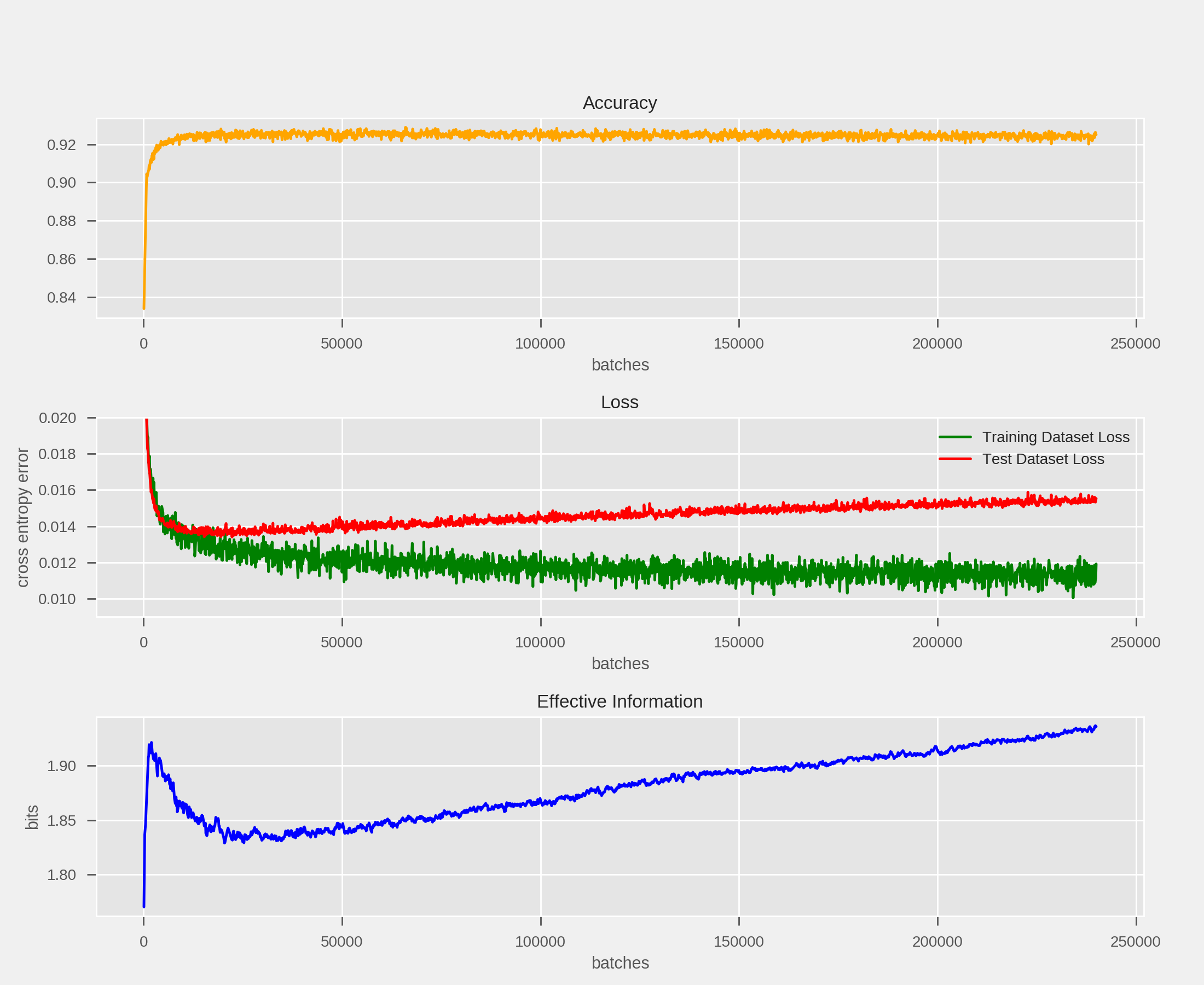Effective Information¶
Theory¶
Effective Information captures something about the information contained in the causal structure of a network (realized as a causal diagram). It is defined as:
or equivalently:
How this quantity evolves during the training of artificial neural networks may illustrate important dynamics of the network, such as “phase changes” during training (such as a transition from generalization to overfitting):

Above, we see how the effective information of a single-layer (no hidden layers) neural network evolves during training. There appears to be a phase of rapid growth (coinciding with the fast, early drop in training and test loss), then a period of decay and leveling off (during which the test dataset loss levels off), folllowed by a phase of slow increase (during which training dataset loss decreases, but test dataset loss increases) as the network “overfits” the data.
Code Documentation¶
-
foresight.ei.H(x, dim=0)[source]¶ Compute the Shannon information entropy of x.
Given a tensor x, compute the shannon entropy along one of its axes. If x.shape == (N,) then returns a scalar (0-d tensor). If x.shape == (N, N) then information can be computed along vertical or horizontal axes by passing arguments dim=0 and dim=1, respectively.
Note that the function does not check that the axis along which information will be computed represents a valid probability distribution.
Parameters: - x (torch.tensor) –
- dim (int) –
Returns: (torch.tensor) of a lower order than input x
-
foresight.ei.degeneracy(model, input=None, shapes=None, norm=lin_norm, device='cpu')[source]¶ Compute the degeneracy of neural network model.
Degeneracy is the entropy of the cumulative, normalized in-weights for each neuron in the graph:
If a shapes argument is provided, then input will not be used and need not be provided. If no shapes argument is provided, then an input argument must be provided to build its computation graph.
Parameters: - model (nn.Module) – neural network defined with PyTorch
- input (torch.tensor) – an input for the model (needed to build computation graph)
- shapes (dict) – dictionary containing mappings from child modules to their input and output shape (created by get_shapes() function)
- norm (func) – function to normalize the out weights of each neuron.
- device – (str): must be ‘cpu’ or ‘cuda’
Returns: degeneracy (float)
-
foresight.ei.determinism(model, input=None, shapes=None, norm=lin_norm, device='cpu')[source]¶ Compute the determinism of neural network model.
Determinism is the average entropy of the outweights of each node (neuron) in the graph:
If a shapes argument is provided, then input will not be used and need not be provided. If no shapes argument is provided, then an input argument must be provided to build its computation graph.
Parameters: - model (nn.Module) – neural network defined with PyTorch
- input (torch.tensor) – an input for the model (needed to build computation graph)
- shapes (dict) – dictionary containing mappings from child modules to their input and output shape (created by get_shapes() function)
- norm (func) – function to normalize the out weights of each neuron.
- device – (str): must be ‘cpu’ or ‘cuda’
Returns: determinism (float)
-
foresight.ei.ei(model, input=None, shapes=None, norm=lin_norm, device='cpu')[source]¶ Compute the effective information of neural network model.
Effective information is a useful measure of the information contained in the weighted connectivity structure of a network. It is used in theoretical neuroscience to study emergent structure in networks. It is defined by:
explicitly:
Which is equal to the average KL-divergence between the normalized out-weights of the neurons and the distribution of in-weights across the neurons in the network.
If a shapes argument is provided, then input will not be used and need not be provided. If no shapes argument is provided, then an input argument must be provided to build its computation graph.
Parameters: - model (nn.Module) – neural network defined with PyTorch
- input (torch.tensor) – an input for the model (needed to build computation graph)
- shapes (dict) – dictionary containing mappings from child modules to their input and output shape (created by get_shapes() function)
- norm (func) – function to normalize the out weights of each neuron.
- device – (str): must be ‘cpu’ or ‘cuda’
Returns: ei (float)
-
foresight.ei.get_shapes(model, input)[source]¶ Get a dictionary {module: (in_shape, out_shape), …} for modules in model.
Because PyTorch uses a dynamic computation graph, the number of activations that a given module will return is not intrinsic to the definition of the module, but can depend on the shape of its input. We therefore need to pass data through the network to determine its connectivity.
This function passes input into model and gets the shapes of the tensor inputs and outputs of each child module in model, provided that they are instances of VALID_MODULES.
Parameters: - model (nn.Module) – feedforward neural network
- input (torch.tensor) – a valid input to the network
Returns: tuple(in_shape, out_shape)}
Return type: Dictionary {nn.Module
-
foresight.ei.lin_norm(W)[source]¶ Turns 2x2 matrix W into a transition probability matrix.
Applies a relu across the rows (to get rid of negative values), and normalize the rows based on their arithmetic mean.
Parameters: W (torch.tensor) of shape (2, 2) – Returns: (torch.tensor) of shape (2, 2)
-
foresight.ei.soft_norm(W)[source]¶ Turns 2x2 matrix W into a transition probability matrix.
The weight/adjacency matrix of an ANN does not on its own allow for EI to be computed. This is because the out weights of a given neuron are not a probability distribution (they do not necessarily sum to 1). We therefore must normalize them.
Applies a softmax function to each row of matrix W to ensure that the out-weights are normalized.
Parameters: W (torch.tensor) of shape (2, 2) – Returns: (torch.tensor) of shape (2, 2)